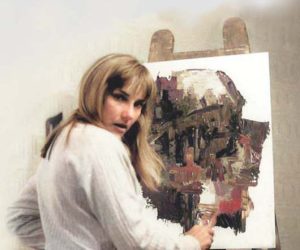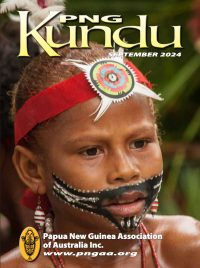Remembering Glenys ‘Gleny’ Köhnke
Well-known artist, sculptor and author, Gleny was born in Brisbane, Qld on 23 October 1948, and was drawing and painting for as long as she could remember, deciding at a young age that she would be an artist—and went on to study art with art educator and future director of the National Gallery of Australia, Betty Churcher, in Brisbane.
Gleny’s father, Roy Köhnke, and her grandfather, Hartwig Gustaf Johannes Köhnke, had a long association with PNG, and when her parents moved to Madang in 1960, they enrolled their daughter at Brisbane’s Sommerville House for five years. It was while she was there that Gleny met Judith Wright, the Australian poet, and some years later Gleny painted her portrait for the Archibald Prize.
In 1965, when Gleny’s parents separated, Gleny lived with her father, and met Rudi Caesar, who took Gleny on as an apprentice to help her gain experience in commercial art, oil painting, sculptures, drawing and even art forgery techniques.
Travelling to Germany in 1969, Gleny was admitted to the Academy of Fine Arts in Stuttgart, and a year later Gleny returned to PNG to live in Port Moresby.
Gleny found many Papua New Guineans were keen to embrace Western culture and urban life, just as she was taking notice of PNG mythology, and decided to incorporate PNG mythology and spirituality into her painting and sculpture.
From 1970 to 1980, Gleny travelled extensively throughout PNG and Irian Jaya, living in villages, recording and painting oral traditions. These paintings appeared in numerous exhibitions in PNG, Australia and Germany.
Her journey in 1970 included travelling by boat—to Samarai, Lae, Madang, and Wewak. She then travelled to Mt Hagen and Minj in the Highlands when a big pig-killing feast was involved. The feast involved 200 pigs and 18 cows being killed. Gleny filmed the event with a Super-8 camera and painted the scene on a mural which went into a solo exhibition in 1971 along with other paintings and sculptures at the Davara Motel in Port Moresby.
In the years 1972–73, Gleny acted as a guide and interpreter for expeditions to the Western Highlands, the Great Papuan Plateau and the Purari River. She visited New Ireland, Bougainville and New Britain the following year.
These travels provided an opportunity to record oral legends and traditions for future books, leaving an indelible mark on her style and subject matter for more than 40 years.
 Time Belong Tumbuna: Legends and Traditions of Papua New Guinea was published in 1973 and The Shark Callers: An Ancient Fishing Tradition of New Ireland Papua New Guinea in 1974. Gleny’s third book, The Green Parrot, a fable of how the birds of PNG got their interesting characteristics, was published in 1976 in PNG.
Time Belong Tumbuna: Legends and Traditions of Papua New Guinea was published in 1973 and The Shark Callers: An Ancient Fishing Tradition of New Ireland Papua New Guinea in 1974. Gleny’s third book, The Green Parrot, a fable of how the birds of PNG got their interesting characteristics, was published in 1976 in PNG.
In 1973, at an exhibition in Port Moresby, then Chief Minister of PNG, Mr Michael Somare, said: ‘Art knows no political or geographical boundaries, but is the true expression of the artist’s relationship with her environment’.
Gleny was approached in 1976 to paint the portrait of PNG’s first Governor-General, Sir John Guise. The late 1970s saw Gleny travel through Europe before returning to Australia in 1980 when her first son was born. Art remained a central focus of her livelihood in Australia, Spain, Germany and PNG.
In 2011, Glenys returned to settle back in Queensland, and passed away on 8 May 2024, after suffering a stroke at the Brisbane nursing home where she lived.
Editor’s Note: Information compiled in this tribute is taken from Glenys’ website and interviews, with the collaboration and approval of her family.



